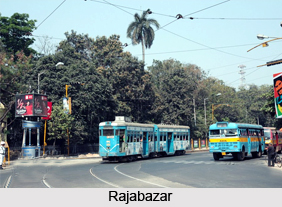 Rajabazar has the busy city-life of Kolkata in West Bengal. Rajabazar has the Muslim concentration with the shoebox shops of watches and textiles.
Rajabazar has the busy city-life of Kolkata in West Bengal. Rajabazar has the Muslim concentration with the shoebox shops of watches and textiles.
Location of Rajabazar
Shyampukur is located approximately in North-Central Kolkata, between CIT Road and AJC Bose Road.
Geography of Rajabazar
The locality has grown around Narkeldanaga Main Road, now renamed as Maulana Abul Kalam Azad Sarani, which acts as a connector between CIT Road and AJC Bose Road. Thus, Rajabazar can be said to be located between Phoolbagan, Narkeldanga and Sealdah. Rajabazar is in a prime location, and Sealdah Railway Station is a stone`s throw distance from Rajabazar crossing. There is a tram depot in Rajabazar also. All civic amenities, such as hospitals, colleges, schools, sanitation, malls, gyms, shopping complexes, cinema halls, mosques, temples are located in and around Rajabazar. Dr. B. C. Roy Children`s Hospital is located at a distance of 2-3 km from Rajabazar.
Market Place of Rajabazar
Rajabazar grew around an old market-place, or bazaar, near Sealdah, on the APC Bose Road. The market exists today, and was initially called "Raja Ramlochan Bazaar" in Bengali. The market was established about 1842 AD on land owned by Raja Ramlochun Ray, a petty zamindar, by Muslim merchants, businessmen, butchers and cattle traders from Bihar and Uttar Pradesh, who had immigrated to Kolkata due to the poor economic condition of Muslims in Bihar and Uttar Pradesh following the Sepoy Mutiny in 1857.
Colony of Rajabazar
The market-place colony of Rajabazar was established around the same time as the Harrison Road, now called Mahatma Gandhi Road, was being built in Calcutta, connecting Sealdah station to Howrah station.
Mosque of Rajabazar
A mosque of Rajabazar was built which exist today and known as the Rajabazar Bari Masjid and there is another larger mosque being renovated which is Jama Masjid Darur-Salaam on Narkeldanga Main Road and several residential quarters were established around that area.
Police Station in Rajabazar
Narkeldanga Police Station was established in 1915, near the canal, on Canal West road. The area is known as "Khalpul" due to the bridge over the canal that connects Rajabazar to Narkeldanga. Before the building of the bridge in 1910, there was a bamboo-stilt bridge over the canal. Boat ferries were also used to transport people and supplies across the canal. Over the decades, further population growth and immigration resulted in the growth and extension of the original settlement further, up to Narkeldanga and Phoolbagan in the east, Sealdah to the south, Mechua and Kelabagan to the west, and further north.
Population of Rajabazar
Rajabazar is densely populated and crowded, with alleys and lanes established. In the Partition of India riots in 1947, in which Muslims were targeted across Kolkata and Bihar, many Muslims from other parts, like Sealdah, Manicktala and Beliaghata moved to Rajabazar.
Riots of Rajabazar
The anti-Muslim riots in Kolkata in 1964, further made Muslims living in areas like Manicktalla, Sealdah, Beliaghata, and throughout Calcutta, flock to Rajabazar for safety. Over time, therefore, it got transformed into a ghetto. After the 1992-93 Hindu-Muslim riots in Calcutta, further Muslims moved to Rajabazar, as a result of which, today, Rajabazar boasts of having the second largest Muslim population in Calcutta after Metiabruz.
Related Articles
Kolkata
West Bengal, Indian State
Tourism in Kolkata
History of Kolkata



















